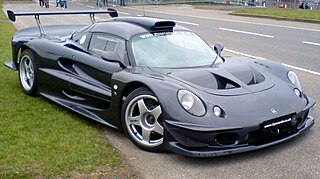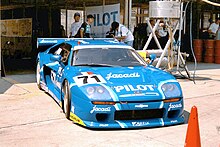
The Nissan Skyline GT-R is a Japanese sports car based on the Nissan Skyline range. The first cars named "Skyline GT-R" were produced between 1969 and 1972 under the model code KPGC10, and were successful in Japanese touring car racing events. This model was followed by a brief production run of second-generation cars, under model code KPGC110, in 1973.

The Porsche 911 GT1 is a car designed and developed by German automobile manufacturer Porsche AG to compete in the GT1 class of sportscar racing, which also required a street-legal version for homologation purposes. The limited-production street-legal version developed as a result was named the 911 GT1 Straßenversion.

Jan Ellegaard Magnussen is a Danish professional racing driver and was a factory driver for General Motors until the end of the 2020 season. He has competed in Championship Auto Racing Teams (CART), NASCAR, the FIA Formula One World Championship and the 24 Hours of Le Mans.

Venturi is a Monaco-based automotive manufacturer. Founded in 1984 by French engineers Claude Poiraud and Gérard Godfroy as MVS. Venturi operated for nearly sixteen years, before declaring bankruptcy in 2000. The same year, Monegasque Gildo Pallanca Pastor purchased Venturi, and decided to focus on electric-powered motors.

The 1996 24 Hours of Le Mans was the 64th Grand Prix of Endurance, and took place on 15 and 16 June 1996. It was won by a Tom Walkinshaw-Porsche prototype run by Joest Racing with drivers Davy Jones, Manuel Reuter and Le Mans rookie Alexander Wurz completing 354 laps. While not being the fastest car on track, it hit the front in the first hour and aside from several pit-stop overlaps, was never headed as other teams hit mechanical troubles during the race. This was Reuter's second Le Mans victory, and the first for Jones and Wurz, who, at 22 years old, became the youngest ever Le Mans overall winner.

The 1995 24 Hours of Le Mans was the 63rd Grand Prix of Endurance, and took place on 17 and 18 June 1995 in one of the wettest races in the event's history with about 17 hours of steady rain. The race was won by the #59 McLaren F1 GTR driven by JJ Lehto, Yannick Dalmas and Masanori Sekiya entered in the GT1 category. This was the first Le Mans win for a driver from Finland and for a driver from Japan. It was also McLaren's first win, at its first attempt - Ferrari had accomplished the same feat with its two cars in 1949, but other manufacturers like Jaguar, Porsche, Ford or Audi achieved their first Le Mans win only after 2, 3 or more attempts. As well as its outright win, the strength of the F1 GTR in the race was underlined by it ultimately filling four of the first five places.

The 1994 24 Hours of Le Mans was the 62nd Grand Prix of Endurance, and took place on 18 and 19 June 1994.

The Mercedes-Benz CLK GTR is a GT1 sports car built and produced by Mercedes-Benz in conjunction with their then motorsport partner AMG. Intended for racing in the new FIA GT Championship series in 1997, the CLK GTR was designed primarily as a race car. As such, the production of road cars necessary in order to meet homologation standards of GT1 was a secondary consideration in the car's design, i.e. the CLK GTR was a homologation special.

Michael Krumm is a German former professional racing driver and current team manager at TOM'S in Super GT. Krumm is best-known for his successes in the All-Japan GT Championship, where he triumphed in the GT500 class in 1997 and 2003 for TOM'S and Nismo, respectively.

The Mercedes-Benz CLK LM was a Group GT1 sports car designed and built by Mercedes-Benz in partnership with AMG to compete in the FIA GT Championship. To satisfy the requirements of competing in the FIA GT Championship, a road-legal version had to be built to homologate the car. That car was known as the Mercedes-Benz CLK LM Straßenversion, and Mercedes-Benz assembled two chassis, one of which was destroyed for crash-testing. The CLK LM went on to win every single championship event in the 1998 FIA GT season, retiring only at the 1998 24 Hours of Le Mans, which was a non-championship event. The removal of the GT1 class from the FIA GT Championship due to the lack of entrants and rising costs meant that Mercedes' GT1 program was brought to a close at the end of 1998. Mercedes instead focussed their efforts on the newly introduced LMGTP class for the 1999 season, which produced the Mercedes-Benz CLR.

The McLaren F1 GTR is the racing variant of the McLaren F1 sports car first produced in 1995 for grand touring style racing, such as the BPR Global GT Series, FIA GT Championship, JGTC, and British GT Championship. It was powered by the naturally aspirated BMW S70/2 V12 engine. It is most famous for its overall victory at the 1995 24 Hours of Le Mans where it won against faster purpose-built prototypes in very wet conditions. The F1 GTR raced internationally until 2005 when the final race chassis was retired.
The FIA GT3 European Championship was a sports car racing series organized by the Stéphane Ratel Organisation (SRO) and regulated by the Fédération Internationale de l'Automobile (FIA). It was a championship derived from the international FIA GT1 World Championship, but meant to provide competition for more amateur racers in closer to production cars. The series used extensive performance balancing and handicap weights to make cars more equal.

A sequential manual transmission, also known as a sequential gearbox, or a sequential transmission, is a type of non-synchronous manual transmission used mostly for motorcycles and racing cars. It produces faster shift times than traditional synchronized manual transmissions, and restricts the driver to selecting either the next or previous gear, in a successive order.

The Lotus Elise GT1 is a race car developed for grand tourer-style sports car racing starting in 1997.
The BPR Global GT Series was a grand tourer-based sports car racing series which ran from 1994 to 1996 before becoming the FIA GT Championship in 1997. The series was founded by Jürgen Barth, Patrick Peter, and Stéphane Ratel as an international endurance racing series to replace the World Sportscar Championship which had ended in 1992.

Pratt Miller Engineering, also known as Pratt & Miller, is an American company involved in the automotive and arms industries. It was founded by Gary Pratt and Jim Miller in 1989. A defense division was added in 2013 and the company was acquired by Oshkosh Corporation in 2020. The company is headquartered in the unincorporated community of New Hudson, in Lyon Township, Oakland County, Michigan. They are best known as service providers for many of General Motors' motorsports programs, including the operation of the Corvette Racing team.

The Sard MC8-R was a modified and lengthened version of the Toyota MR2 (SW20) built for GT racing by Toyota's SARD works team.

The Venturi Atlantique was a mid-engined, fiberglass-bodied French sports car produced by Venturi Automobiles from 1991 to 2000.

Group GT1, also known simply as GT1, was a set of regulations maintained formerly by the Fédération Internationale de l'Automobile (FIA), for Grand Tourer racing. The category was first created in 1993, as the top class of the BPR Global GT Series, and was included in the 24 Hours of Le Mans. It fell under FIA regulation from 1997, after the BPR series came under the control of the FIA, becoming known as the FIA GT Championship. The category was dissolved at the end of 2011. The category may be split into four distinctive eras, from its debut in 1993–1996, 1997–1998, 2000–2009, 2010–2011.

The 1000 Kilometres of Paris was an endurance race, mainly for sports cars, which was held at the Autodrome de Linas-Montlhéry in France from 1956 to 1995.
















